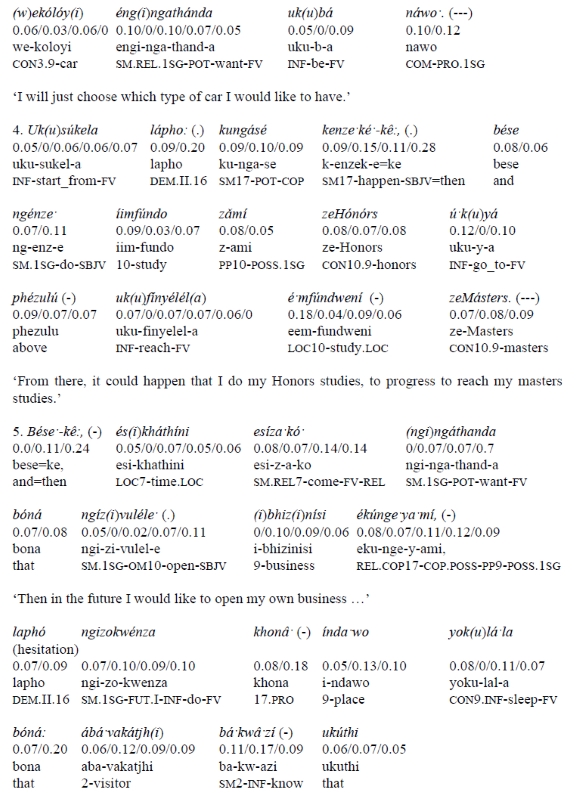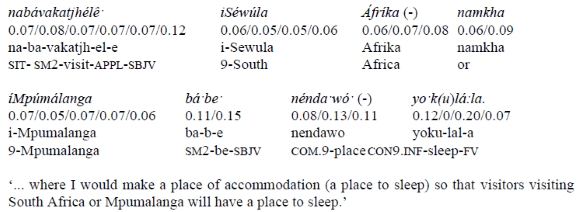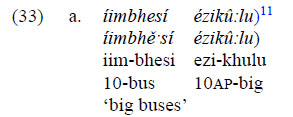Services on Demand
Article
Indicators
Related links
-
 Cited by Google
Cited by Google -
 Similars in Google
Similars in Google
Share
Stellenbosch Papers in Linguistics Plus (SPiL Plus)
On-line version ISSN 2224-3380
Print version ISSN 1726-541X
SPiL plus (Online) vol.66 Stellenbosch 2023
http://dx.doi.org/10.5842/66-1-909
Penultimate lengthening in isiNdebele: A system and its variations
Lotta AunioI; Thera CraneII; Richard KerbsIII
IDepartment of Languages and Helsinki Institute of Sustainability Sciences, University of Helsinki, Finland E-mail: lotta.aunio@helsinki.fi
IIDepartment of Languages and Helsinki Institute of Sustainability Sciences, University of Helsinki, Finland E-mail: thera.crane@helsinki.fi
IIIDepartment of Languages, University of Helsinki, Finland E-mail: richard.kerbs@helsinki.fi
ABSTRACT
Lengthening of the penultimate syllable in a word, phrase, or utterance is common across Bantu languages, especially in Eastern and Southern Bantu languages. Despite the prevalence of the general phenomenon, there is significant cross-linguistic diversity in how PUL is instantiated. The aim of this paper is to describe the PUL patterns and variation in isiNdebele, a Nguni language spoken in South Africa. IsiNdebele is closely related to Zulu and frequently spoken in situations of intense contact with Zulu, but its realisation of penultimate lengthening nevertheless shows important differences from what has been reported for Zulu and other Nguni languages. In addition, penultimate lengthening in isiNdebele shows significant internal variation, both across speakers and across utterances produced by the same speaker. This variation has implications for both phonological and syntactic analyses of this language: Many studies of phonological phrasing in other Nguni languages use penultimate length as the main phonetic cue for phrase boundaries, but a strict correlation between PUL and phrasing cannot be confirmed for isiNdebele. Lengthening also depends on factors such as speech rate, emphasis, and careful vs. casual speech.
Keywords: penultimate lengthening; isiNdebele; Bantu; phonological phrasing; syntax; information structure
1. Introduction
Prominence of the penultimate syllable in a word, phrase, or utterance is common across Bantu languages. Probably the most frequent realisation of penultimate prominence is through lengthening of the syllable, especially through the insertion of a tone-bearing mora; this lengthening often affects tonal patterns (Hyman 2013:310-311). Penultimate lengthening is pervasive in many (perhaps most) Eastern and Southern Bantu languages in which the Proto-Bantu contrast in vowel length has been lost (Hyman 2013), including the Bantu languages spoken in South Africa. Example (1) shows lengthening and tone patterns for lexically toneless isiNdebele verbal infinitive forms when pronounced in isolation. With monosyllabic verb stems, the last vowel of the infinitive prefix uku- is lengthened (1a); with other verb stems (1b-d), the final root vowel (before the final vowel -a) is lengthened.1

Despite the prevalence of the general phenomenon, there is significant cross-linguistic diversity in how PUL is instantiated. The aim of this paper is to describe the PUL patterns and variation seen in isiNdebele.
IsiNdebele (S407, ISO 639-3: nbl) is a Nguni language spoken in South Africa. It is closely related to Zulu (S42, ISO 639-3: zul), and its speakers often have significant multilingual contact with speakers of Zulu, but its realisation of penultimate lengthening nevertheless shows important differences from what has been reported for Zulu and other Nguni languages. In addition, penultimate lengthening in isiNdebele shows significant internal variation, both across speakers and across utterances produced by the same speaker. This inter- and intra-linguistic variation has implications for both phonological and syntactic analyses of this language. Many studies of phonological phrasing in other Nguni languages use penultimate length as the main phonetic cue for phrase boundaries, but a strict correlation between PUL and phrasing cannot be confirmed for isiNdebele. Lengthening also depends on factors such as speech rate, emphasis, and careful vs. casual speech. Phrase-final but utterance-medial words, and even words that are syntactically phrase-medial, can sometimes be produced with full PUL; in addition, pragmatic factors can sometimes suspend PUL. Therefore, isolated examples of penultimate lengthening cannot automatically be taken as indicative of syntactic phrasing in isiNdebele.
The remainder of this section presents the phenomenon of penultimate lengthening in Bantu languages, introduces the isiNdebele language and speakers, and outlines the methods used in this study. Section 2 deals with the phonetic realisation of PUL in isiNdebele and how it interacts with the tonal system. The contexts affecting PUL that were examined for this study are presented in Section 3. In Section 4, our isiNdebele findings are compared to available data from other Nguni languages. Section 5 presents our conclusions along with topics for future research.
1.1 Penultimate lengthening in Bantu languages
Penultimate lengthening occurs in many Bantu languages, especially - but not exclusively - in Southern and Eastern Bantu areas. Hyman (2013) argues that PUL is not inherited from Proto-Bantu, but rather developed in a number of largely areal innovations, most often occurring in languages that also exhibit the loss of lexically contrastive vowel length. PUL varies in its instantiation: Hyman's survey of PUL describes several parameters along which languages differ in their realisation of the phenomenon, including the target of lengthening (utterance-, phrase-, or word-level), the number of length distinctions (some languages contrast two lengths, while others have a three-way contrast between short, mid-length, and full-length), and the utterance types (declaratives, imperatives, etc.) allowing or requiring penultimate lengthening. See Hyman (2013) for further details.
The syntax and phonology of penultimate lengthening have received considerable attention in studies of Bantu languages, especially Nguni and Sotho-Tswana languages (e.g. Odden 1990a, 1990b; Philippson 1998; Zerbian 2007; Cheng and Downing 2007, 2009; Downing 2010; Downing and Pompino-Marschall 2013; Hyman 2013; van der Wal and Hyman 2017; Zerbian 2017, among many others). In these studies, syntactic phrasing is typically described as coinciding with phonological phrasing, which, in turn, is marked by penultimate lengthening. Penultimate lengthening is thus often described as a two-way distinction, namely, the presence or absence of lengthening in defined syntactic contexts. However, the phonetic realisations of PUL in many Bantu languages evince not merely a binary opposition, but rather three or more length distinctions, possibly accompanied by other phonetic cues such as devoicing, pitch reset, or boundary tones.
In Nguni languages, the instantiation of the three main length distinctions depends primarily on whether a word is in utterance-final, (syntactic) phrase-final but utterance-medial, or phrase-medial position. This distinction can be seen with the isiNdebele noun ísíphî:la 'maize' in (2). In (2a), where the word is pronounced in isolation, ísíphî:la has full length and a falling tone on the penultimate syllable. In (2b), where it occurs in a phrase-final position but is not utterance-final, ísíphî·la has mid-length on its penultimate syllable, and still a falling tone. In (2c), ísíphíla occurs in phrase-medial position and exhibits no penultimate lengthening. As we will discuss in greater detail, other factors, such as speech rate, can also affect the realisation of PUL. However, the pattern seen in (2) represents the most common realisation of PUL.2

Over the years, this three-way contrast has been described in the Nguni literature using many different terms. For example, Lanham (1960:126-127), in his comparative account of Nguni phonology, describes two types of penultimate lengthening "which [are] not a permanent part of any morph or word", namely, "long utterance-penultimate [and] utterance-medial instances of imposed length bound to the penultimate syllables of words". Cassimjee and Kisseberth (2001:355-356) write that ya-marked verbs in Xhosa show final lengthening "even though [they are] not literally final"; that is, they are not utterance-final, but phrase-final. Zeller, Zerbian and Cook (2017) investigate syntactic phrasing in Zulu and find that the lengthening induced by phrase-final, utterance-medial forms is not as salient as the PUL found utterance-finally. However, detailed studies that deal with phenomena beyond individual verb forms are still lacking (Zerbian and Barnard 2008).
A three-way contrast is also reported for the non-Nguni Southern African languages Tswana and Shona (Cole 1955; Fortune 1980; both cited in Hyman 2013:313). In addition to full phrasal penultimate lengthening, Tswana and Shona lengthen the penultimate syllable of every word, but this lengthening is not as long as the phrasal lengthening (Hyman 2013).
In addition to the three commonly described lengths, some authors also refer to one or more additional length categories. For Ziervogel (1967:56-57), "short" vowels in Nguni languages (and in Sotho, Tsonga, and Venda) occur in certain ideophones and monosyllabic demonstratives, and these contrast with "normal" length vowels found elsewhere in non-lengthened contexts. In the other direction, Cope (1966:30) states that he has "excluded the exaggerations resulting from 'emotional overlay'" from his description of length in Zulu. This "emotional overlay" can lengthen vowels for pragmatic reasons.
Although penultimate lengthening is a fairly well-studied phenomenon in southern Bantu languages, and although the three (or more) lengths have been widely noted in the literature, most recent studies of PUL, including those dealing with PUL in Nguni languages, treat it primarily as a binary distinction relevant to the phonology-syntax interface (e.g. Jokweni 1995; Buell 2005; Buell 2006; Cheng & Downing 2007; Donnelly 2009; Cheng and Downing 2014). In general, very little is noted about phonetic details or the distribution of the three reported lengths in different contexts beyond certain syntactic constructions (e.g. conjoint/disjoint forms or relative clauses); phonetic and phonological distinctions between phrase and utterance boundaries are not often dealt with. A significant exception is Zeller, Zerbian and Cook's (2017) controlled experiment on the realisation of PUL in Zulu, in which three verb forms in both phrase-medial position and phrase-final but utterance-medial position were investigated.
1.2 IsiNdebele language and orthographic conventions
IsiNdebele (ISO 639-3: nbl) is a Nguni Bantu language spoken mostly in the Gauteng and Mpumalanga provinces of South Africa, with almost 1.1 million home-language speakers as of 2011 (Statistics South Africa 2012), as well as a large population of speakers with a different primary home language (Webb 2002:78). Classified as S407 in the "Guthrie" coding system for Bantu languages (Maho 2009), isiNdebele is also referred to in the literature as South(ern) Ndebele or (Southern) Transvaal Ndebele. We use the endonym isiNdebele because it is preferred by many speakers, but we retain the English designations for other language names.
It is important to note that isiNdebele differs from two other Nguni languages with similar names: first, a language spoken primarily in Zimbabwe and known as "Zimbabwean Ndebele", "Northern Ndebele", or (isi)Ndebele (S44, ISO 639-3: nde); and second, "Northern (Transvaal) Ndebele", also known as Sindebele and Sumayela Ndebele (S408, no ISO code), which is spoken mostly in South Africa's Limpopo province. The realisation of PUL in both of these languages exhibits several differences from PUL in isiNdebele (see Section 4).
Although it has a robust community of first- and second-language speakers, isiNdebele is, percentage-wise, the smallest of South Africa's eleven official languages. It was also the last of the official languages to be implemented as a language of education, and was first introduced in primary schools in the 1980s. It is now taught at primary, secondary, and tertiary levels. Furthermore, isiNdebele is spoken in situations of significant contact with other Nguni languages, especially Zulu, and with Sotho-Tswana languages, especially Northern Sotho (Sepedi; S32, ISO 639-3: nso). Despite its comparative minority status and intense contact with other languages, isiNdebele maintains a number of distinguishing features. For extensive discussions of isiNdebele from linguistic and socio-cultural perspectives, see Aunio and Fleisch (2019).
When citing isiNdebele data in this article, we follow - with a few additions - the orthographic conventions of isiNdebele (PanSALB 2008; see Mahlangu 2016 for a history of isiNdebele orthography and additional references). As penultimate lengthening and other length distinctions are not marked in the isiNdebele orthography, lengthening is indicated in the examples with the following IPA symbols: (:) for full lengthening, and (·) for partial lengthening. In addition, our notation marks tone. Lexical and grammatical underlying H tones are marked by underlining the vowel contributing the H tone (a).3 Surface H tones are marked with an accent (á), a circumflex (â) indicates a falling tone pattern on a lengthened vowel, a caron (ă) marks rising tones, and L tones are left unmarked (a). The details of the isiNdebele tone system are still under investigation, and the tone marking in this paper therefore reflects our present understanding of the system. The right edges of phrase boundaries, syntactic and/or phonological, are indicated with a right parenthesis, and hash symbols (#) mark the ends of utterances.
1.3 Methodology
Data for this paper were collected in the years from 2015 to 2019, over the course of several field trips to South Africa and visits from South African scholars to the University of Helsinki.4This corpus includes data from numerous speakers with different geographical and sociolinguistic backgrounds. It was not collected as part of a carefully controlled experiment on PUL, and therefore the aim of this paper is to present general tendencies of PUL in isiNdebele rather than phonetic details as they are instantiated in controlled contexts.
We analysed several types of data: first, a set of sentences specifically elicited to control for syntactic and pragmatic factors that might be expected to influence vowel length;5 second, a large body of other elicited and naturalistic data, not specifically elicited with penultimate lengthening in mind; and third, a large set of shorter utterances elicited to target a maximal set of tonal and other phonological contrasts. The first set of sentences was elicited with isiNdebele scholar Peter Mabena (University of South Africa) during his research visit to the University of Helsinki in 2017, while the other data come from many speakers of isiNdebele living in South Africa's Gauteng and Mpumalanga provinces.6 These latter data confirm both the trends and the variation seen in the utterances that were controlled for syntax.
We measured the length of penultimate vowels in about 2,800 words using Praat.7 The segmentation was made using common acoustic cues (e.g. Turk, Nakai and Sugahara 2006), and only contexts that facilitate reliable segmentation were measured (except in the text sample in Appendix A, in which all vowel lengths are marked). For example, contexts in which the penultimate (PU) vowel is followed by a nasal were avoided whenever possible, as defining segment boundaries between vowels and nasals is challenging; furthermore, nasals sometimes share the preceding vowel's tone and length specifications in isiNdebele (Aunio et al. 2019). As there is significant inter- and intra-speaker variation, and the length distinctions occur along a continuum rather than falling into discrete categories, the measurements should be understood as illustrative rather than indicative of discrete categories.
2. The phonetics and phonology of penultimate lengthening in isiNdebele
IsiNdebele has a typical Nguni vowel length system: The lexical vowel length distinction reconstructed for Proto-Bantu has been lost, but certain lexemes and (especially) grammatical morphemes have underlyingly long vowels, often as a result of consonant deletion. For example, the noun class 10 prefix, historically ízim-, is usually shortened to íim- in normal speech. The remote past marker aá- is underlyingly a long vowel with a rising tone; in normal speech, the vowel is often shortened. Vowel length is not marked in the isiNdebele orthography, apart from the class 10 prefix (see Section 3.2). In this paper we mark lexical long vowels only when they surface. As will be shown in Section 3, lexical length may suspend penultimate lengthening.
As noted in the introductory section, isiNdebele has at least a three-way contrast in its realisation of penultimate lengthening. In this section, our first aim is to describe and illustrate this contrast in more detail (2.1). Because the realisation of length also affects surface tone patterns, we then move on to describe the basics of the isiNdebele tone system (2.2) and interactions between tone and penultimate lengthening (2.3).
2.1 Penultimate lengthening: a three-way contrast
Three categories of penultimate length have been identified in isiNdebele: (i) utterance-final, that is, the forms in which the PU is fully lengthened; (ii) (syntactic) phrase-final but utterance-medial, with vowel length between the fully lengthened utterance-final form and the short phrase-medial form; and (iii) phrase-medial, with short PU vowels. In this section, we present typical length realisations of the three types of lengthening. It should be kept in mind that there is considerable variation in the actual amount of lengthening in almost all contexts, as discussed in detail in Section 3 below. It is also important to note that lengthening seems to be a continuum rather than a set of fixed categories. We have chosen to present this contrast in terms of three lengths that match with three patterns of tonal realisations described in the next section.
Figures 1a-c, which depict the examples presented in example (2) above, show the word isiphî:la 'maize' as pronounced in the three positions by a single speaker: utterance-finally in Figure 1a, utterance-medially but phrase-finally in Figure 1b, and phrase-medially in Figure 1c (each of these positions is discussed in more detail in Section 3, and the tone realisations in Section 2.3). While there is a lot of variation between speakers, the average length of the penultimate vowels for one speaker can give a general picture of the contrast. For this speaker, the average length of the penultimate vowels in utterance-final position is 0.26 s, while the mid-length vowels average 0.16 s and short vowels 0.10 s. These averages were measured in utterances that consisted of isolated sentences. The natural text in Appendix A demonstrates that the clear full PUL attested in isolated sentences may be used much less frequently and less regularly in longer stretches of speech. PUL of over 0.20 s is realized only at the very end of the story in Appendix A and at the end of one sentence in the middle of the story.



Figures 2a-c show the verb -betha 'hit' in the three positions with their corresponding lengths, as recorded by a single speaker (different from the speaker in Figures 1a-c). In Figure 2a, the future form ngizómubé:tha 'I will hit her/him' is utterance-final and shows full lengthening of the PU vowel. In Figure 2b, the verb ngizómubé:tha 'I will hit her/him' is phrase-final but followed by a postposed object within the same utterance (ngizómubé:tha úmfówê:thu 'I will hit him, my brother' ; see Section 3.1.2), resulting in medium lengthening. In Figure 2c, the verb ngizobéthá 'I will hit' is phrase-medial and has a short PU vowel (ngizobéthá úmfówê.thu 'I will hit my brother').



As noted, the length distinctions do not form clear categories but rather span a continuum, with pragmatic factors blurring the distinctions even further. Therefore, it would be useful to find other phonetic cues of phrasing. In Xhosa, for example, the ends of intonation phrases are marked with final devoicing (Bloom Ström 2022). Final devoicing is attested in isiNdebele, as well, but has not yet been systematically studied. While there appear to be inter-speaker differences - some speakers use final devoicing to mark utterance boundaries far more frequently than others do - final devoicing does not seem to be as prominent in isiNdebele as it is in Xhosa. For example, Figures 1b and 1c above show utterance-final forms with complete devoicing of the final syllable, whereas the final syllable in Figure 2a is somewhat devoiced compared to the utterance-medial corresponding syllables in Figures 2b and 2c, but still has some voicing on the final vowel.
2.2 Tone in isiNdebele
IsiNdebele has a privative tone system typical of Bantu languages (Hyman 2009). Only H tones function on the phonological level. That is, H tones are lexical properties of roots and stems, and they interact with other H tones, whereas L tones are the default surface tones assigned to any toneless tone-bearing units (TBU) after the phonological rules have applied. In addition to lexical tones, like many other Bantu languages, isiNdebele makes use of tones that are used to distinguish grammatical forms. Both lexical and grammatical tones interact with penultimate lengthening in isiNdebele (see Section 2.3).
IsiNdebele's lexical tone system differs from those of its Nguni neighbours in that some of the lexical tone contrasts have been neutralized. Nominal stems have only a two-way tonal contrast - H and toneless (Ø) stems - and the position of the H tone follows from phonological rules (see Aunio et al. 2019 for an account of the nominal tone system). This is the system reconstructed for Proto-Bantu verb roots (and most extended stems) and found in many modern Bantu languages, including isiNdebele and other Nguni languages, but it is less common in nominal systems (Aunio forthcoming).
The words in example (3) are lexically toneless. The H tone of the augment (u-, a-, or i-; also known as the preprefix) is spread from the augment to the stem. In (4), the words have a lexical H tone in addition to the augment H. The lexical H tone also spreads if there are more than two stem syllables (for details of the spreading rules, see Aunio et al. 2019). Examples (5) and (6) demonstrate the same tone sets with infinitive forms: The words are lexically toneless in (5) but H-toned in (6). The augment u- of the infinitive form also contributes a H tone. On the surface, these basic lexical tonal contrasts are often realized on the penultimate syllable. Compare, for example, the level H tone on the PUL in (3a) and (5a) to the falling pattern in (4a) and (6a), and the falling pattern in (3b,c) and (5b,c) to the level H tone in the PUL of (4b,c) and (6b,c).

In longer stems, the lexical tone contrast is neutralized when the augment is present, as any H tones contributed by a pre-APU (ante-penultimate) syllable target the PU syllable and not the final. These facts are demonstrated in (7).

In Nguni languages, tonal realisations are also affected by a set of consonants called depressors (e.g. Downing 2009). IsiNdebele depressor consonants are represented with the orthographic symbols bh, d, g, dz, dlh, j, z, dl, and gq. In addition, sonorant consonants have depressor counterparts that are distinguished from the non-depressors only by tone realisations and are not marked in the orthography. For details on the phonetic realisations of depressor consonants, see Schulz (ms.); for their tonal effects, see Downing and Aunio (2018).
2.3 Interaction of penultimate lengthening and tone
Penultimate lengthening interacts with tone realisation. IsiNdebele differs from other Nguni languages in that tone distinctions are often realized on the penultimate and final syllables, whereas in the other Nguni languages, tone distinctions are typically realized one syllable earlier, that is, on the antepenultimate and penultimate syllables (Aunio et al. 2019). At least in fully lengthened forms, the penult has an additional tone-bearing unit, making room for different, often more complex, surface tone patterns (Hyman 2013:311); the lengthening itself is induced by phrase and/or utterance boundaries, which also condition tone realisations. In addition, tonal realisations are conditioned by depressor consonants. The interaction of tone, length, syntactic position, and depressor consonants is exemplified below with bisyllabic nominal stems; the same processes also apply to other parts of speech.
Bisyllabic nominal stems in isiNdebele have two underlying tone types: H-toned stems and toneless stems. The stem H is underlyingly associated with the stem-initial syllable (e.g. the syllable tlha in [8a]). These stem Hs spread to the final syllable of the noun in phrase-medial position, as in (8a); the same process is seen in Figure 2c with a H-toned verb in phrase-medial position. In addition to the stem H, the augment has a lexical H tone, which does not spread in the case of H-toned bisyllabic stems as in (8a), as the following syllable already has a H tone. In toneless stems (8b), however, the augment H is the only H tone and therefore spreads to the penult, which is the target of H tone spreading for any pre-APU or prefix H tones (see Figure 1c with the same tone pattern on ísíphíla). In (8a) and (8b), the tonal difference is realized on the final syllable. Whenever there is a depressor consonant on the onset of one or both of the stem syllables, the H tone is delinked from that syllable: In H stems, the depressors (dl and nd in [8c,d]) can lower either the first or the second/final syllable, while in toneless stems, the augment H is only realized on the augment itself if the stem has a depressor in the first stem syllable (g in [8e]).

In utterance-final position, the penultimate vowel is fully lengthened, allowing for falling and rising tone patterns, which are not usually found on short vowels (see exceptions in Section 3.3). The utterance-finality introduces an additional conditioning factor, as final H tones are not allowed in this position: H-toned bisyllabic stems have a level H tone on the lengthened PU, but the final syllable is realized as L (9a). As before, toneless stems have only the augment H tone. The augment H spreads to the PU of toneless stems, but only to the first mora of the lengthened PU, forming a falling tone on the long vowel (9b). Whereas phrase-medial forms instantiate the tonal difference on the final syllable (as in example [8]), it appears on the PU in utterance-final forms - compare the pitch traces of the penultimate syllables in Figures 1a (falling) and 2a (level H). Again, H tones are delinked from syllables with depressor consonants, but only the first TBU following the depressor undergoes delinking (9c-e).

The middle length category, found utterance-medially but at phrase boundaries, combines the tonal properties of the two extremes (phrase-medial and utterance-final). The lengthening of the PU, although usually shorter than the lengthening at utterance-final position, makes possible the same falling and rising surface tone patterns as in utterance-final position. At the same time, the utterance-medial position licenses the realisation of final H tones, generally prohibited in utterance-final position. H-toned stems with mid-length have the same tone pattern on the PU as do fully lengthened forms, with the addition of a final H; compare (10a,b) with (9a,c). With toneless stems, the falling pattern of the fully lengthened forms appears on the PU (10c), unless the spreading is blocked by depressor consonants (10d).

Figures 3a-c demonstrate the three realisations: Figure 3a shows the utterance-final form with rising PU but no final H, Figure 3b has the mid-length form with both rising PU and final H, and the phrase-medial form in Figure 3c has only the final H.



The realisations of lexical H tones on the penultimate and the final vowel in different utterance positions are summarized in Table 1. As the combinations of values for the three positions are different, tonal realisations can be used as a diagnostic for determining the phrase boundaries. However, given that tones contributed by pre-APU syllables do not target the final at all, these diagnostics do not work for longer words with lexical H tone or for lexically toneless words, even if the latter are short and have a H tone contributed by an augment.8

3. The conditioning of penultimate lengthening in isiNdebele
Having described some of the phonetic and phonological features of penultimate lengthening in isiNdebele, we can now move on to a discussion of particular conditioning (and non-conditioning) environments. The main factor conditioning PUL on a word is whether it occurs phrase-medially or phrase-finally. This contrast is also the seminal distinction described in studies of Zulu, Xhosa, and other Nguni languages: PUL is taken as an indication of the right edge of a prosodic phrase, which also coincides with the right edge of a syntactic phrase (Jokweni 1995; Buell 2006; Cheng and Downing 2007, 2009; Zeller, Zerbian and Cook 2017, among others). Within this main division, there are factors that affect or even suspend PUL, including, for example, utterance type, discourse features, and pragmatic intent. Lanham (1960:128) describes the surface realisation of PUL as involving two layers: The first layer expresses the "closest syntactic bonds" and is structurally essential, while the second, intonational layer is more optional.
In addition, PUL is subject to both inter- and intra-speaker variation. In natural speech, as mentioned above, phrase-medial PUs can be lengthened and phrase-final PUs can be shortened (see Sections 3.1.2 and 3.5); phonetically, these are realized with middle-length and short PUs, respectively, which makes it challenging to use PUL as the sole diagnostic of phonological and syntactic phrasing.
In this section, we first explore the main division between PUL-conditioning and non-PUL-conditioning environments, namely, phrase (non-)finality. Section 3.1 describes PUL (and its occasional suspension) in phrase-final position, and Section 3.2 describes the lack of PUL usually seen in phrase-medial position. We then move on to discuss in more detail some of the syntactic environments that affect phrasing, along with some pragmatic factors that can lead to (non-)lengthening that is not entirely predictable based on syntax alone. In Section 3.3, we describe the interaction of PUL with the conjoint/disjoint distinction, which is the most famous correlate of syntactic phrasing in Nguni and other Bantu languages. PUL in subordinate clauses is treated in Section 3.4, and Section 3.5 briefly exemplifies some of the effects of pragmatics on PUL. Finally, Section 3.6 summarizes the (non-)conditioning environments and points to areas for further research.
3.1 Phrase-final position
As a general rule, PUL appears regularly on phrase-final words and almost always on utterance-final words. As noted above, utterance-final words are fully lengthened while utterance-medial but phrase-final words generally receive mid-length. Example (11) repeats the phrases that appear in Figures 1a-b with the word ísíphî:la 'maize' in phrase-final position: full PUL utterance-finally in (11a) and medium PUL utterance-medially in (11b).9

In this section, we first look at constructions that are usually found in utterance-final position: Section 3.1.1 exemplifies utterance types that employ PUL, while Section 3.1.2 presents some exceptions to this general trend. Utterance-medially, phrase-final lengthening shows much more variation. These forms are explored in Section 3.1.3.
3.1.1 Utterance types with PUL
Hyman (2013) presents utterance type as one of the parameters along which languages differ in their instantiation of penultimate lengthening. All the examples of isiNdebele presented so far have been declarative, with full PUL utterance-finally. Full PUL is also found in content questions (12) and yes/no questions (13) without the question particle na (which is exemplified in Section 3.1.2.), as well as in imperatives (14) and hortatives (15).
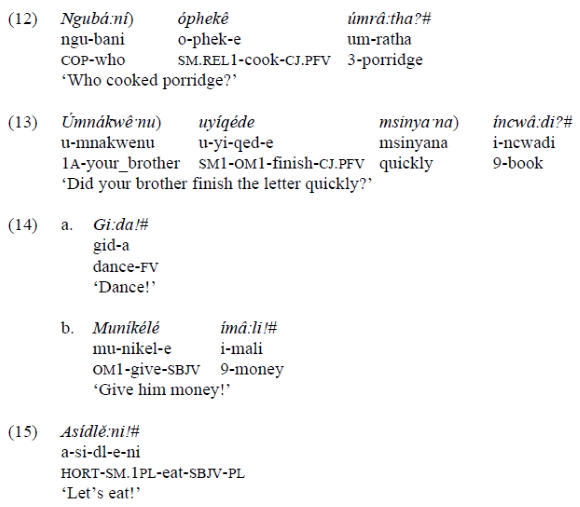
Vocatives have full PUL, as in examples (16a-c). Alternatively, with some words, the final vowel is lengthened instead (16d). This final lengthening seems to be connected with the final falling tone but warrants further research (see other examples with final long vowels in Sections 3.1.2 and 3.1.3).

Note that in example (16c), the word i:yé 'yes' has full PUL while in utterance-medial position. This also applies to other interjections, such as yĕ:bo 'yes', kâ:hle/awúkâ:hle 'wait a bit/just a moment', and bayé:de, a respectful greeting for a king. These and other interjections phrase separately from what follows and usually have PUL, often full PUL (17a). Other interjections have long vowels in other positions and no PUL (17b). As with final long vowels, it seems that lexically and/or pragmatically induced long vowels suspend PUL. For example, á:feke, an interjection of surprise, has a long vowel on the APU while áwa: 'no' has a lengthened final vowel.

3.1.2 Phrase-final suspension of PUL
We found only two environments, namely exclamative utterances and ideophones, in which a short penultimate vowel length systematically occurs both phrase-finally and utterance-finally. Lengthening of phrase-final and even utterance-final positions can be suspended in several other contexts - for example, with question particles - but significant variation occurs in how much shorter than expected these PU syllables are.
The exclamative forms are mostly verbs in the conjoint form that are expected to occur phrase-medially (see Section 3.3 for more details on the conjoint/disjoint distinction). In exclamative usage they occur phrase-finally, where lengthening is usually expected. While in the conjoint perfective (18a,b) the lack of PUL could be an effect of the final long vowel with the H tone (see examples in [40] below), the exclamative utterance type is the only PUL-suspending factor in the conjoint present (18c). Example (18d) shows a non-lengthened adjective in utterance-final position when used as an exclamative, again with a lengthened final vowel.

Ideophones have short penultimate vowels even in utterance-final position (19a,b). Some ideophones also have an utterance-final H tone, which is not usually allowed (19c), and some have a long final vowel (19d). The full range of prosodic features of ideophones needs more research.


Utterance-final monosyllables, such as monosyllabic demonstratives (20a), the adverb nje 'now' (20b), and the question particle na (20c), usually shorten the penultimate vowel of the preceding word to some extent. The vowel of these monosyllables is often lengthened. in addition, all monosyllabic words attested so far in isiNdebele have either a falling or a rising tone, which, however, is usually realized as level H when not lengthened (as lá in 20d). The PU of the word preceding the monosyllabic word can optionally have some PUL, possibly indicating separate phrasing from the final word, as with the question particle in (20c,e), but the lengthening of the vowel of the monosyllabic word itself is a lexical property of these words and is amplified by pragmatic factors. Further research is required to determine whether the complex tone pattern (falling or rising tone) lengthens the vowel, or whether the complex tone pattern is made possible by the underlying length of the vowel in these monosyllables.
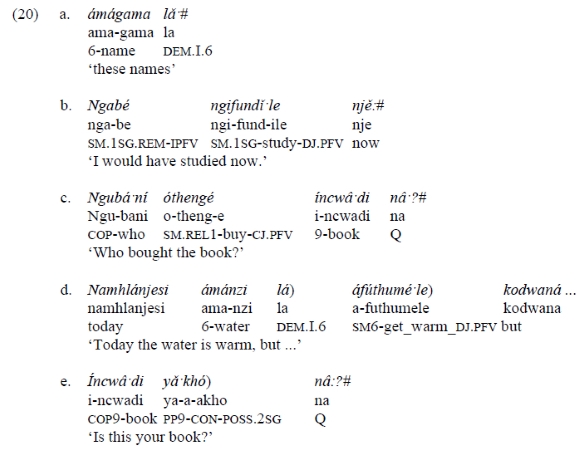
In addition to the monosyllabic words, there are some monosyllabic stems to which normal lengthening is not applied, at least by some speakers. For example, lápha 'here' was pronounced in all contexts without any lengthening by one speaker: utterance-medially in fast/normal speech (21a) and slow speech (21b), as well as utterance-finally (21c). For other speakers, lápha behaves as expected, with medium lengthening utterance-medially (22a) and full lengthening utterance-finally (22b). The same stem seems to be found in ngaphá 'this side, here'. The locative prefix nga- is short even in utterance-final contexts, while the syllable phá is slightly lengthened (23), again indicating that the underlying long vowel of phá is the reason for the lack of PUL in these words.
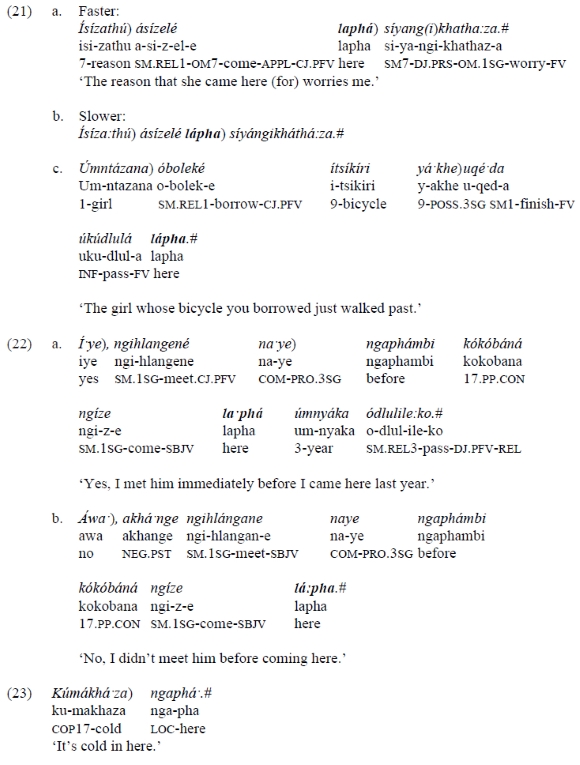
3.1.3 Other phrase-final contexts
This section describes phrase-final forms typically found utterance-medially. Phrase-finality is the main conditioning factor for PUL in these contexts, and PUL is much less salient utterance-medially than in the utterance-final forms presented in Section 3.1.1. In addition, PUL seems to be optional in most utterance-medial contexts.
In canonical SVO sentences, objects are phrase-final and are expected to have PUL. In example (24a), the object is not final in the sentence and has medium PUL. Example (24b) shows that the PUL of objects is optionally suspended in phrase-final position. Utterance-finally, objects have regular full PUL (24c).

Lengthening is also found in topicalized objects that are moved to preverbal position. In example (25a), íncwâ:di is topicalized and the PUL, which has full length in the utterance-final position (as in 24c), is reduced to medium length. As will be shown below (see Section 3.3), the presence of an object prefix on the verb extraposes any lexical object that follows it to outside the verb phrase. In (25b), the extraposed object ikû:khu is followed by a dislocated subject.
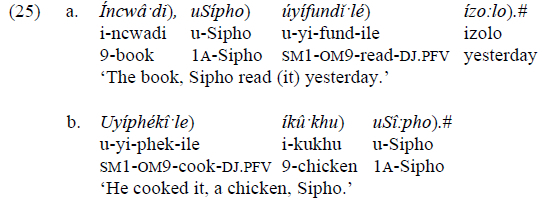
Like objects, subjects have optional PUL. This applies to overt subjects in SVO sentences (26a-c), and to subjects followed by relative clauses and other subclauses (see 3.4). Subjects dislocated to postverbal position have full PUL utterance-finally (27a). Utterance-medially, dislocated subjects (27b) are more likely to have PUL than subjects in the canonical position (27c).10
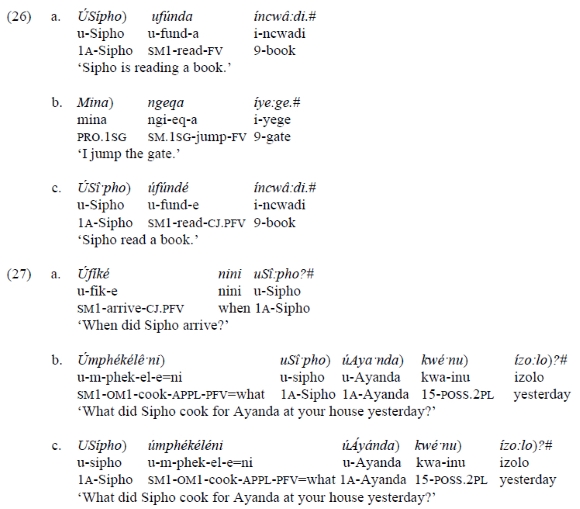
Focused constituents occurring with the copulative prefix may optionally receive PUL. In (28a), PUL on the focused word is actually even longer than on the utterance-final word, possibly due to emphasis (see Section 3.5). In (28b) and (28c) there is no PUL at all on the focused words.

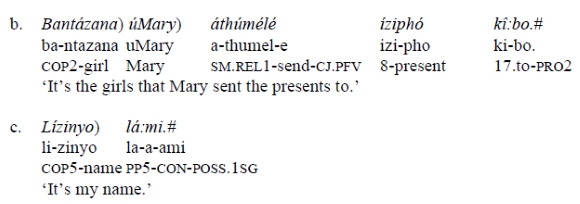
As shown in the examples in (29), words in paused lists are normally lengthened. In addition, list intonation with final H tone is added: For example, the word ímíthi 'trees' in (29b) is normally realized outside of list contexts as ímî:thi, with full PUL and no final H. In (29), the listed items have full PUL utterance-medially; this length can also be realized as medium length.

Phrase-final polysyllabic noun stems, especially those with four or more stem syllables, tend to have PUL suspended in utterance-medial contexts in which shorter stems would have medium PUL (30a-c). While with other types of stems there is variation in the length of the PU, the PUs of reduplicated stems are more systematically shortened in utterance-medial position (31a,b). A complete description of this variation is beyond the scope of this paper.

3.2 Phrase-medial position
Phrase-medial words are not expected to have penultimate lengthening. This lack of lengthening is seen most regularly with conjoint verb forms, to be discussed in more detail together with their disjoint counterparts in Section 3.3. Noun phrases show more variation and allow lengthening in some words that appear to be phrase-medial. Lengthening is also attested phrase-medially with preverbal auxiliaries. In addition to certain syntactic contexts, slow speech, emphasis, and other pragmatic factors may lengthen the PU of phrase-medial words; these pragmatic factors are discussed in Section 3.5. The considerable number of contexts in which PUL can occur in phrase-medial position again hampers the use of PUL as the sole diagnostic for phonological phrasing in isiNdebele.
Conjoint verb forms phrase together with the following element and normally have a short penultimate vowel. In (32), lengthening does not appear on the verb itself but rather on the last word in the phrase, indicating the right boundary of the Complementiser Phrase (32a, also shown in Figure 2c above).
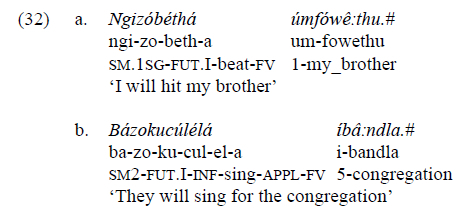
For noun phrases, determining phonological phrase boundaries using syntactic criteria is less straightforward than for verb phrases. This is especially the case in noun-modifier phrases where the modifier is an adjective, a numeral, or a possessive noun. In these phrases, PUL may optionally appear on the phrase-medial noun depending on the speech rate, as in (33a-c). In contrast, Noun Phrases in which the modifier is a demonstrative or a possessive pronoun mostly allow lengthening only on the modifier, as in (33d,e). Similar PUL patterns have been reported in Xhosa and Zimbabwean Ndebele (Lanham 1960:133), and also in PUL languages beyond the S languages, such as Makonde (P23, ISO 639-3 kde; Kraal 2005; Manus 2018) and Ngangela (K12b, ISO 639-3 nba; Maniacky 2002, cited in Hyman 2013). In sequences of modifiers, the non-final modifiers optionally receive penultimate lengthening, as in (33f).

Some phrase-medial words are nevertheless frequently lengthened (with medium or even full lengthening). It is our impression that these words are likely to be emphasised, and that this emphasis may be the source of the lengthening. These include the preverbal negative auxiliaries angé:khe/angê:ze 'won't, will never' (34a) and ază.nge/akhá:nge 'didn't, has/have never' (34b,c). IsiNdebele, like other Nguni languages, has many preverbal auxiliaries, and their lengthening properties are an important topic for future research.


In summary, although phrase-medial words are not expected to have PUL, there are many contexts in which phrase-medial PUL is allowed or possibly even required. This variation calls for further research in isiNdebele and possibly in other Nguni languages as well.
3.3 PUL and the conjoint/disjoint distinction
Penultimate lengthening is related to phrasing, and an important factor in syntactic and phonological phrasing in isiNdebele is the conjoint/disjoint distinction. Nguni languages are well-known for segmentally distinguishing, in certain tense-aspect configurations, verbs that share vP constituency with the following sentence element (including, for example, objects and adverbials) and those that do not (e.g. Buell 2006; Zeller, Zerbian and Cook 2017; see van der Wal and Hyman 2017 for a general overview of the phenomenon and numerous language-specific discussions regarding Nguni and other languages). Verb forms of the former type are labelled "conjoint" (35a, 36a) and the latter "disjoint" (35b, 36b). (Non-)constituency is closely related to focus in many instances.12

Disjoint verb forms are always phrase-final. In contrast, conjoint verb forms phrase together with what follows and cannot occur phrase-finally. Generally speaking, therefore, only the disjoint can occur at the end of an utterance (37a vs. 37b).13 See, however, the discussion of exclamatives in Section 3.1.2.
The syntax of the conjoint/disjoint distinction also has implications for the semantics and information structure of the utterance (van der Wal 2017; Crane and Fanego 2020). In terms of prosody, the correlation between PUL and the morphologically marked conjoint/disjoint distinction is rather regular. Conjoint forms are short, while disjoint forms are usually lengthened. The relative length, medium or full, of disjoint verb forms depends on position in the utterance, speaker emphasis, and speech rate, among other factors. As described above, medium length generally occurs utterance-medially, and full length occurs utterance-finally.
Because it correlates with constituency, the conjoint/disjoint distinction is associated with a number of semantic and pragmatic effects, including distinctions in focus and in salient aspectual interpretations. In (38), for example, (38a) is a neutral statement, while in (38b), the disjoint form emphasizes the fact that the speaker is working and not, for example, playing, in town.

The conjoint/disjoint distinction is marked segmentally in two tense/aspect forms, as shown in examples (35-36), namely, the present (ya- vs. Ø)15 and the perfective (-ile vs. -é). Since the syntactic conditioning of these two tense/aspect forms differs slightly, we will discuss them in turn.
In the present (disjoint ya- vs. unmarked conjoint), both the disjoint form and the conjoint form can be marked with an object prefix (39a-c), but only the disjoint form can then be followed by an overt object (39b vs. 39e). The conjoint form must be followed by another element within the same phrase (39c-d). When no object prefix is marked on the verb, disjoint forms cannot be followed by a lexical object (39f), although they can be followed by non-constituent items such as adverbials (39g). In contrast, conjoint forms without object markers can be followed by a lexical object (39h). Double-object constructions give rise to additional complexities, which we will not discuss here.

As can be seen in (39), disjoint forms are usually pronounced with full PUL; this lengthening may be shortened in utterance-medial position.
The perfective is frequently described in the Nguni literature as a perfect or a recent past. It typically gives rise to present-state interpretations with so-called "change-of-state" verbs (e.g. úlámbî:le 's/he is hungry'). As noted above, disjoint perfective forms end with -ile and conjoint forms end with -é. Botne and Kershner (2000) analyse -ile forms as bimorphemic in Zulu (-il-e). In isiNdebele, certain interactions between morphology and semantics do not seem to be as clear-cut as they are in Zulu (Crane and Fanego 2020; see the following paragraph for a brief discussion), and we therefore remain agnostic about the internal make-up of -ile. Perfective -ile also occurs together with other tense/aspect forms, such as past be- (e.g. bekálambî:le 's/he was hungry'). The conjoint perfective suffix -é has H tone and underlying length, as also reported for Zulu (Cope 1966:32). As the form normally occurs in non-lengthening context, the underlying length does not surface except in, for example, careful speech. When this happens, the tone pattern on the suffix is falling and the preceding penultimate vowel is not lengthened; the lengthening appears on the final vowel in the same fashion as with some monosyllabic stems presented in Section 3.1.2 (see example [50b]).
As shown in (40), the syntactic conditioning of the perfective conjoint/disjoint distinction is generally similar to that described above for the present. The conjoint -é ending occurs phrase-medially, before a direct object or some adverbials (40a,d). Disjoint -ile occurs phrase-finally (40c). However, unlike in the present tense, -ile forms can be followed by a direct object even if the verb is not marked with an object prefix (40b);16 in these cases, polarity is emphasized (e.g. 'I did eat a mango' or 'S/he did write a book'). Emphasis is also optionally marked with extra lengthening: The PU of the verb in (40e) is actually longer than the PU of the utterance-final word (see Section 3.5).
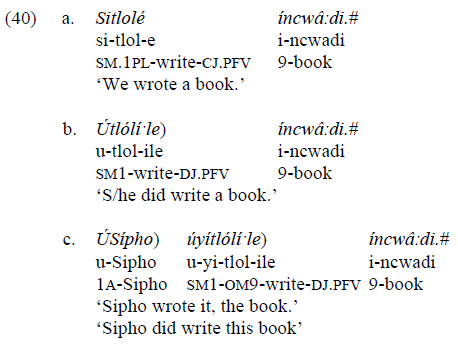
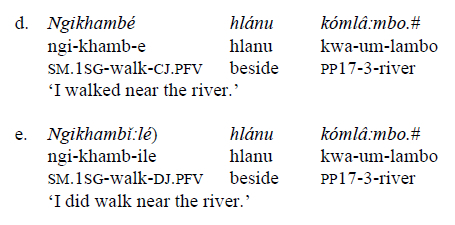
In forms with -ile, the conjoint/disjoint distinction can be morphologically obscured due to imbrication, a morphophonological process whereby -ile becomes intertwined with the verb stem rather than directly suffixed to it (see Bastin 1983). With imbricated forms, PUL and tone can be the only means of marking the conjoint/disjoint distinction. In literature on Zulu, it is frequently noted that in cases where both imbricated and non-imbricated forms are available for so-called "change-of-state" verbs (verbs that typically indicate a present state when paired with perfective morphology), non-imbricated -ile forms reference a state change that occurred in the past, and imbricated forms are used to describe a present state (e.g. Botne and Kershner 2000). Although the Zulu pattern is also a general pattern, in isiNdebele, imbricated verb forms are often preferred even if both imbricated and non-imbricated forms are available (Crane and Fanego 2020). Imbricated forms can have both kinds of meaning (state change and ongoing state), and the interpretation depends on other contextual factors, including whether the forms are pronounced with penultimate lengthening.
In the isiNdebele tense/aspect system, only the present and perfective appear to mark the conjoint/disjoint distinction morphologically. Nevertheless, it seems that prosodic marking makes it possible to express the same phrasing differences in other tense/aspect categories, despite the lack of morphological differentiation. Detailed studies on possible tone and length distinctions are still needed. In their study of Zulu, Zeller, Zerbian and Cook (2017) find that in the remote past tense and one of the future tenses, length distinctions are similar in the same phrasal constituency configurations as with the morphologically marked verb forms; preliminary study of these forms in isiNdebele suggests a similar contrast. Example (42), which is also shown in Figure 2 abov,) shows a future form in isiNdebele with full lengthening in utterance-final position (42a); mid lengthening in phrase-final but utterance-medial position (42b, which has an object-marked verb followed by an overt object); and no lengthening in phrase-medial position (42c). Example (42) also demonstrates that the realisation of a wordfinal H tone is possible utterance-medially (42b,c), but not utterance-finally (42a). In (43), the remote past form has utterance-medial full length that parallels the emphatic function found with the disjoint perfective in example (40).


3.4 Subordinate clauses
Subordinate clauses can induce PUL prior to and at the right edge of the subclause. Lengthening on the word preceding the subordinate clause, and on its last word, occurs regularly with conjunctions, as illustrated in (44a-c). Example (44d) demonstrates that the complementizer bóná also phrases with the following word and can induce PUL on the preceding word. In (44e), in contrast, PUL is not realized on the previous word. Therefore, it seems that lengthening at the right edge of subordinate clauses is more regular. The conditioning factors require further research.17


A morphological distinction similar to the conjoint vs. disjoint forms in the present and perfective can also be seen in isiNdebele relative clauses, where disjoint contexts generally have a final relative marker -ko (see Zeller 2004 for an overview of relative clause formation in Nguni and other languages of South Africa). In (45a), the relative-clause verb is suffixed by -ko, which also marks the end of the phrase, while in (45b), the relative-clause verb does not have this suffix, as it is not phrase-final.

Disjoint-like forms with -ko frequently have full or partial lengthening of the syllable prior to -ko, but in fast speech, lengthening in non-utterance final contexts may be minimal or even absent. Lengthening patterns with relative clauses require further study. Examples of object relative clauses are shown in (46-48), with the latter two examples additionally contrasting slow, careful speech with faster production of the same sentence by the same speaker. Example (46) shows an utterance-final -ko form in a clefted context, with full lengthening.

Examples (47) and (48) show two phrase-final but utterance-medial -ko forms. In (47), production varied between full (0.27 s) and partial (0.13 s) penultimate lengthening before -ko, while (48a,b) varied between full (0.24 s) and no noticeable lengthening (or, at the most, minimal lengthening, as the second form was pronounced overall much more quickly than the first; the penult was measured at 0.09 s, compared to a 0.07 s penult for zibúdisi in the same utterance). Note that in (47), the relative clause is followed by an overt subject that is different from the subject (and object) of the relative clause, while (48) has no following overt subject, and the subject of the main clause is the same as the relative-clause object. The regularity, if any, of the length distinction in these two contexts requires additional systematic investigation. The differing speech rate versions in (47) and (48) also demonstrate that the lengthening of the word preceding the relative clause is optional, as observed with some other subordinate clauses above.
Example (49) shows two contexts in which the relative-clause verb is followed by additional constituent material and does not end in -ko. No lengthening of the verb is observed.
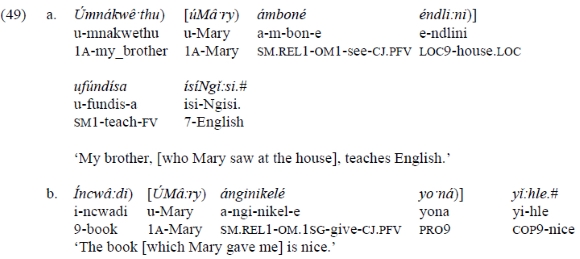
In the examples above, (49a) is a non-restrictive relative clause, and (49b) is a restrictive relative clause. These two relative clause types are not morphosyntactically distinguished in isiNdebele, but there may be some prosodic differences. Specifically, in our current limited data set, material preceding non-restrictive relative clauses always exhibits at least some degree of penultimate lengthening, as in (49a), while lengthening seems to be optional before restrictive relative clauses - full or partial lengthening occurs in some, but not all, of our examples (49b vs. 45a). This situation may contrast with that of Durban Zulu, where Cheng and Downing (2007) report greater systematicity: Durban Zulu non-restrictive relative clauses always phrase separately (PUL on preceding head noun phrase), and restrictive relative clauses always phrase together with the preceding noun (no PUL on preceding head noun phrase). Our observations on isiNdebele are tentative, as we were only able to collect systematic relative clause data from one speaker, and the optional lengthening before restrictive relative clauses might be due to that speaker's careful speech. However, lengthening before some restrictive relative clauses occurred with this speaker even in more quickly produced utterances, suggesting at least that the restrictive/non-restrictive distinction is not universally marked with PUL or the lack thereof.
3.5 Pragmatic factors affecting PUL
As demonstrated with relative clauses in (47) and (48), variable speech rate can increase or reduce the amount of lengthening of the penultimate vowel. In addition, emphasis can also be expressed by lengthening: In phrase-final words, emphasis adds extra length, and PUL can occur on phrase-medial words not normally lengthened, when these words are emphasized. Because pragmatic factors were not systematically taken into account in our data collection, only some tentative observations are presented here. Appendix A presents a transcribed short story demonstrating that full PUL is not always realized in normal speech between utterances (of the five sentences, it appears only in sentences 2 and 5). On the other hand, many non-PUL vowels are slightly lengthened, as, for example, in the word ngizokwénza in sentence 5 (Appendix A).
Fully lengthened vowels may occur utterance-medially in slow and/or careful speech; compare the fast and slow versions in (50a,b) and (51a,b). In (50a), the subject does not have PUL, while it does in (50b). The sentence in (51a) has the regular medium length at the right edge of its phrases, while in (51b), which is pronounced slowly, all vowels in lengthening positions are lengthened to full length, with the final PU being even longer than it normally is.

With phrase-final elements that are already lengthened, the lengthening may be further reinforced when emphasis is added. For example, the word 'our [place]' has full PUL utterance-medially in (52a), as the location is emphasized over the time. In (52b), the PUL of the word bó:ke 'all' is longer than that of the utterance-final word. Focused words with optional PUL can also be emphasized by lengthening the medium length PU to full length utterance-medially, as in (28a) above.

Pragmatic factors also affect phrase-medial words. In extreme cases of slow and careful speech, the PU of every word may be fully lengthened, as in (53a): PUL on the first two words is only slightly shorter (around 0.18 s) than on the last two words (around 0.20 s). In (53b), the first word and the last word of the sentence have the longest PU (0.23-0.26 s), while the PUs of the middle words are slightly shorter (0.18-0.21 s). Of these words, ábá:nyé and bafí:ke would be
expected to have no PUL at all, and the fact that ábá:nyé 'some' has the longest PUL in the whole utterance points to the fact that this word is the one emphasized (see Section 3.2 for discussion on ază:nge).

3.6 Summary
Before comparing isiNdebele to other Nguni and other Bantu languages in Section 4, we briefly summarize our findings and also restate areas of interest for any further studies on PUL in isiNdebele and other Nguni languages. Table 2 lists most of the contexts we have discussed above and how PUL can be realized in these contexts.

As shown above, the main criterion that determines whether a word has PUL is its position in the phrase: Phrase-final words have PUL while phrase-medial do not. However, as we have seen, phrase boundaries cannot be determined based on PUL alone, as phrase boundaries do not always induce PUL and, on the other hand, PUL can be induced by factors other than syntactic phrase boundaries. For example, vocatives and exclamatives do not have PUL even in utterance-final position, while preverbal auxiliaries often have PUL. Also, PUL is seemingly optional in many contexts in isiNdebele, but further studies may reveal conditioning factors that have not been taken into account in this study.
The variety of data utilized in the study have revealed many areas ripe for further studies. While we have attempted to explore as many types of phrases and utterances as possible, the internal structure of the phrases in our data is rather simple. Research on - for example - more complex noun phrases or on verb phrases with variable preverbal auxiliaries and other verb forms involving several words might shed more light on phrasing in isiNdebele. A closer look at subordinate clauses may also reveal more regularities in the realisation of PUL. Of interest are also the suspension of PUL in nouns (and possibly other words) that have longer stems, and the interaction of underlying vowel length with PUL.
Finally, the conjoint/disjoint distinction is well documented for Nguni languages, but only for forms that are morphologically marked for this distinction. Our data show that other verb forms can make the same distinction prosodically, though it remains to be seen if this distinction is available with all verb forms and if the prosodic marking in these forms is so salient that some prosodic forms can only occur in certain contexts or with certain meanings.
4. IsiNdebele penultimate lengthening in relation to other Nguni languages
Penultimate lengthening in the Nguni languages is a complex phenomenon that involves at least phonetics and phonology, utterance types, syntax, information structure, and pragmatics. This multidimensionality has stimulated an increase in research on the phenomenon - especially in relation to linguistic theories - but it seems that a comprehensive analysis of all aspects of penultimate lengthening for any given language is still lacking. In the discussion which follows, we compare our initial observations of isiNdebele in these areas with what has been described for the other Nguni languages. Since analyses of different languages are different in scope, depth, and focus, our comparative discussion is necessarily also somewhat uneven.
On the phonetic/phonological level, we have identified a three-way length distinction in isiNdebele, which we have presented as two "layers" of lengthening. In the first layer, syntactic structure, together with information structure, determines whether PUL is expected. In the second layer, the position of the word within the utterance, together with pragmatic considerations, determines how salient the lengthening is. Utterance-final words generally have full PUL, while utterance-medial words in phrase-final position have more moderate lengthening. However, this basic system sees much variation, both between speakers and in different utterances from the same speaker. Emphasis and other pragmatic factors may reinforce PUL even in utterance-medial positions. Pragmatic factors may also lengthen the PU of phrase-medial words that are otherwise not lengthened; they can also suspend lengthening in contexts where it is expected.
Most accounts looking at PUL from the syntactic point of view mention only the "first layer" of PUL, that is, a two-way distinction of the presence vs. the absence of PUL. This distinction is described as "phrase-penultimate lengthening" (e.g. Cheng and Downing 2007 on Zulu; Donnelly 2009 on Phuthi), more specifically as lengthening of the penult of a phonological phrase (e.g. Jokweni 1995 on Xhosa),19 or as prepausal lengthening (e.g. Khumalo 1987; Buell 2005 on Zulu). However, the factors of the "second layer" seem to be in effect in all Nguni languages. The three-way distinction of length - short, medium, and full PUL - has been described by, for example, Lanham (1960) and Ziervogel (1967). Lanham (1960:125, 127) discusses Zulu, Xhosa, Swazi, and "Rhodesian" Ndebele (Zimbabwean Ndebele) and draws a distinction between "the shorter utterance medial 'penultimate length' and utterance-final 'penultimate length'". These represent the two types of "imposed length", that is, length which is not a lexical/morphological property of any words. Doke (1973[1927]:25) describes "half-length" as something that "usually occurs when words are combined or reduplicated, and a long stressed syllable has lost its full length and stress". He adds a fourth length category, "prolonged length", for exclamatory purposes.
Detailed studies on length realisations are mostly missing for the Nguni languages. As mentioned before, the variable lengths were noted by scholars decades ago, but the topic has not been picked up again since tools for the acoustic analysis of speech became available. A recent exception is Zeller, Zerbian and Cook (2017), which presents a controlled experiment measuring Zulu speakers' length distinctions between phrase-medial and phrase-final syllables in utterance-medial position. Their study focused on a set of three tense/aspect forms (present, future, and remote past), and its observations of length distribution align with our observations in isiNdebele. First of all, the phenomenon of PUL is characterised by both inter- and intra-speaker variation. Nevertheless, a stable difference in average lengths (25-50 milliseconds depending on the speaker) was confirmed in the Zulu study. We measured the average lengths for one speaker of isiNdebele, and we also found a stable difference, in this case, around 60 milliseconds. It should be noted that Zeller, Zerbian and Cook (2017) measured syllable length, while we measured vowel length. In a study of Xhosa, Bloom Ström (2022) also discusses the actual phonetic length of penultimate syllables in different contexts. Although Bloom Ström (2022) does not present a controlled experiment, the results confirm a medium length for utterance-medial, phrase-final PUs (in Bloom Ström's analysis, end of phonological phrase, but not end of intonational phrase).
As described in Section 2.2, isiNdebele differs from other Nguni languages in its tone spreading processes. In isiNdebele, the target of the H tone spread is generally one syllable further to the right (see Aunio et al. 2019 for details). This difference raises the question of tone behaviour especially in the (phrase-final, utterance-medial) medium-length forms, for which detailed descriptions of other Nguni languages are particularly scarce. In isiNdebele, the utterance-medial position permits the same H tone spread to either the PU or the final syllable both phrase-medially and phrase-finally; that is, the medium-length forms pattern tonally with the short forms. In Zulu, even the less salient lengthening found utterance-medially is prominent enough to block the movement of H tones to the PU (Zeller, Zerbian and Cook 2017:317), meaning that the tonal behaviour of the medium-length forms - at least in the verb forms examined by Zeller, Zerbian and Cook - patterns with that of the long forms. Donnelly (2009:302) mentions "discourse emphasis" used in Phuthi and other Nguni languages, in which the present indicative form (ya-) can be used utterance-medially with a short penultimate vowel but behaves tonally as a final form: The tone target is the antepenult. The fact that tone realisations follow the opposition between the lengthened and the non-lengthened in Zulu, and possibly in some other Nguni languages, could indicate that this opposition is more salient in these languages, whereas in isiNdebele, phrase-final forms can have different tone patterns depending on their position in the utterance and are not so clearly distinguished from phrase-medial forms by tone.
In terms of utterance types, there seem to be some differences among the Nguni languages (see Table 3 for an overview). Hyman (2013) presents a study of utterance types in relation to penultimate lengthening in utterance-final position. (Zimbabwean) Ndebele (S44) is one of the languages in his sample and is reported as having PUL in all examined environments: declaratives, yes/no questions, content questions, ideophones, paused lists, imperatives, hortatives, vocatives, exclamatives, and vowels preceding monosyllabic words. This is, according to Hyman (2013), a possible sign of (Zimbabwean) Ndebele being innovative in terms of PUL: PUL probably first marked declarative utterances - as is still the case in, for example, Shekgalagari - and gradually spread to other utterance types. While isiNdebele also has PUL in most utterance types examined, there are some differences from Zimbabwean Ndebele and from other Nguni languages. Exclamatives, ideophones, and some vocatives do not have utterance-final PUL in isiNdebele. These utterance types that defy the general rule of utterance-final penultimate lengthening may indicate that the general PUL is still in the process of spreading to these utterance types (Hyman 2013).

Xhosa and Zulu differ from isiNdebele with regards to questions and exclamative utterances. In these languages, yes/no questions do not have PUL at all (or much less than in declaratives), while in content and alternative questions there is more variation and optionality (Cope 1966:49; Khumalo 1981:36; Poulos and Msimang 1998:435; Jones 2011; Bloom-Ström 2022). Exclamative utterances, on the other hand, have PUL in Zulu (Cope 1966:49).
Questions in Sindebele (sometimes known as Northern Transvaal Ndebele) contrast with questions in isiNdebele but follow a similar pattern to that found in Xhosa and Zulu. Sindebele does not have utterance-final PUL in yes/no questions, and utterance-final PUL in content questions seems to be at least somewhat optional. We have not yet found evidence of a lack of PUL in Sindebele exclamatives.20
Penultimate lengthening is often described as the diagnostic for phonological phrasing, which coincides with syntactic phrasing in the Nguni languages (e.g. Cheng and Downing 2007), and verb phrases involving morphological marking of conjoint and disjoint forms are most often studied in this respect. As presented above, this phonological phrasing is rather consistent in isiNdebele and also similar to what is described for the other Nguni languages. Conjoint forms do not generally allow PUL, but disjoint forms usually have PUL because of their syntactic structure, where whatever follows the verb is not phrased within the same vP. However, the same kind of clear phrasing difference based on the presence vs. absence of PUL is not easily found in other kinds of syntactic constituents in isiNdebele, as most contexts allow for variation in lengthening of the PU. This variation is caused by pragmatic factors such as speech rate, but also speaker-specific tendencies.
In Durban Zulu, as described by Cheng and Downing (2007), there is a systematic difference between non-restrictive and restrictive relative clauses in how they induce PUL. With non-restrictive relative clauses, the left edge of the relative clause induces PUL on the preceding word (the final word of the head noun phrase), while restrictive relative clauses phrase together with the preceding word. Again, isiNdebele shows more variation: PUL on the preceding word is usually found with non-restrictive relatives, but sometimes also with restrictive relatives.
Lexical long vowels are generally a PUL-suspending context in Nguni languages, including isiNdebele. This applies to, for example, monosyllabic words that can suspend PUL on the preceding word. This also happens with suffixes with an underlying long vowel, such as the conjoint perfective suffix -é with which there is no PUL even in slow speech, but it is the final vowel that is lengthened instead. Interjections with lexical long vowels also suspend PUL. Ideophones seem to be the only type of words that categorically suspend PUL (except in Zimbabwean Ndebele).
Lanham (1960:130) lists some words as usually having PUL in Nguni, "probably due to a frequent syntactic isolation", for example, ukuze 'so that' (Zulu, Zim. Ndebele), ukuthi 'that' (Zulu), and kodwa 'but' (Xhosa, Zim. Ndebele), but these do not appear to have exceptional PUL in isiNdebele.
The characteristics of penultimate lengthening in isiNdebele are generally similar to those in the other Nguni languages. However, differences are found in, for example, some non-declarative utterance types, with grammatical particles, and in tone realisations. That said, intra-language variation is often greater than the variation found between Nguni languages. The most striking difference between our findings for isiNdebele and the existing descriptions of the other Nguni languages is the free and pragmatically controlled variation in realisation of PUL in isiNdebele and the resulting difficulty of using penultimate lengthening as the sole diagnostic for phonological and/or syntactic phrasing. This difference may be an artefact of differing elicitation techniques and differences in the data sets examined.
5. Conclusion
In this paper, we have provided an initial description of the main features of isiNdebele penultimate lengthening and have shown that isiNdebele penultimate lengthening has many of the features described for other Nguni languages. As the isiNdebele language is still under-described in most areas (although much work is underway), our study has raised many interesting questions which deserve further research in isiNdebele, as well as in other Nguni languages and other Bantu languages with PUL. Some of these areas of interest have already been mentioned in Section 3.6. In the following discussion, we suggest a few additional areas for further investigation.
As the data utilised in this paper come from a variety of speakers in a variety of data collection settings, they permit general observations rather than precise comparative measurements. Therefore, more controlled experiments are called for. These could target, for example, inter-speaker differences by measuring the relative lengths of vowels or syllables within words and phrases instead of the absolute length measured in this study. Based on the initial findings of this study, a set of sentences targeting the interesting lengthening environments could be designed and recorded with a larger, more balanced sample of speakers. Additional lengthening contexts, going beyond the scope of the present study, should also be studied. These include, for example, the length behaviour of verb forms that do not have morphological marking of conjoint/disjoint forms, following up on the experiment with speakers of Zulu described in Zeller, Zerbian and Cook (2017). Furthermore, perception experiments could shed light on the issue of whether tone patterns specific to certain positions in phrasing actually contribute more to differentiation of phrasing than do length realisations. Finally, to counterbalance experimental data, measurements of PUL in longer, spontaneously produced texts and dialogues will give us a better idea of the instantiation and variation of PUL in natural speech. The short text in Appendix A represents a first step in this direction for isiNdebele.
The seemingly free variation in the realisation of PUL in many contexts in isiNdebele poses a challenge for using PUL as the sole diagnostic for phonological and subsequent syntactic phrasing, which seems to work in a much more straightforward way in Zulu (Cheng and Downing 2007, 2009) and Xhosa (Bloom Ström 2022). As suggested by Zeller, Zerbian and Cook (2017) for Zulu, it is possible that these languages have two types of phonological boundaries: the intonational phrase boundary that is marked by full PUL at the right edge of the phrase, and another, less salient, boundary marking a smaller prosodic unit, as demonstrated by the three degrees of lengthening. This seems to be exactly the case in Xhosa, where devoicing marks the end of intonational phrases but not smaller phonological phrases (Bloom Ström 2022). As other possible phonological diagnostics of different types of phonological phrasing., Zeller, Zerbian and Cook (2017) suggest preboundary lengthening and possible resetting of downstepped H tones after a phrase boundary. Another question regarding different types of boundaries concerns the extent to which utterance-medial, pragmatically induced full lengthening affects the realisation of tones. Our analysis predicts that utterance-final H tones would be realised in these contexts, but it is possible that full lengthening signals such a strong boundary that tonal properties are reset, and final H tones would therefore not surface. These contexts should be systematically studied in isiNdebele.
While most utterance types make use of regular PUL in isiNdebele, there is variation that calls for further examination. For example, PUL is sometimes suspended in vocatives, and it is not clear in the light of current data whether this suspension is related to the H tone of the final syllable. More broadly, as there seems to be variation as to which utterance types employ penultimate lengthening in different Nguni languages, a comparative study of Nguni utterance types, possibly extended to other southern Bantu languages, could shed light on the historical development of PUL.
This article presents the first descriptive account of PUL in isiNdebele. We have attempted to present the basic features of PUL and some of factors that interact with it; a comprehensive description of the phenomenon in isiNdebele would require an entire book. We measured phonetic realisations of PUL in numerous contexts and defined the system to comprise three length categories, which also interact with the realisation of tones on the penultimate and final syllables. We have shown that in addition to utterance type and syntactic structures, pragmatic factors, inter-speaker differences, and conditions such as speech rate can influence the production of PUL in various contexts. While broad trends are clear, there is considerable variation in the details. We hope that this preliminary account, which has illustrated this variation, will catalyse further study of PUL in isiNdebele and in other Nguni languages, both in controlled experimental settings and in more naturalistic settings, ultimately leading to a better understanding of the range and limits of variation in PUL, the factors that condition PUL, and, more broadly, how phrasing works in Bantu languages.
Abbreviations and conventions
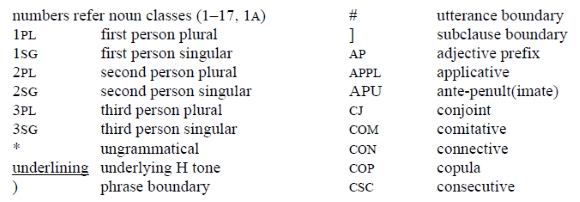
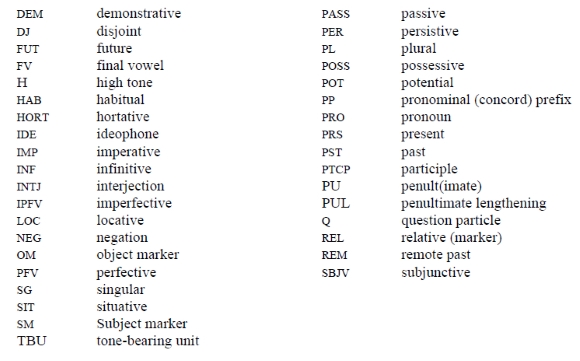
References
Aunio, L. forthcoming. Nominal tone contrasts. In L. Marten, N. Kula, E. Hurst & J. Zeller (eds.), Oxford guide to the Bantu languages. Oxford: Oxford University Press.
Aunio, L. & A. Fleisch (eds.). 2019. Linguistic diversity research among speakers of isiNdebele and Sindebele in South Africa. (Studia Orientalia 120). Helsinki: Finnish Oriental Society. [ Links ]
Aunio, L., S. Schulz, A. Laine & N. Philippova. 2019. Nominal tone in isiNdebele. In L. Aunio & A. Fleisch (eds.), Linguistic diversity research among speakers of isiNdebele and Sindebele in South Africa. Helsinki: Finnish Oriental Society. pp. 283-311. [ Links ]
Bastin, Yvonne. 1983. La finale verbale -ide et l'imbrication en bantou. Tervuren: Annales du Musée Royal de l'Afrique Centrale. [ Links ]
Bloom Ström, E-M. 2022. Preliminaries of Xhosa intonation: Pitch, vowel length and devoicing. Stellenbosch Papers in Linguistics Plus 62(2): 81-111. https://doi.org/10.5842/62-2-894 [ Links ]
Botne, R. & T. Kershner. 2000. Time, tense, and the perfect in Zulu. Afrika Und Übersee 83:161 -180. [ Links ]
Buell, L. 2006. The Zulu conjoint/disjoint verb alternation: Focus or constituency? ZAS Papers in Linguistics 43: 9-30. https://doi.org/10.21248/zaspil.43.2006.281 [ Links ]
Buell, L. C. 2005. Issues in Zulu verbal morphosyntax. PhD dissertation, University of California at Los Angeles. [ Links ]
Cassimjee, F. 1998. IsiXhosa tonology: An optimal domains theory analysis. München: LINCOM Europa. [ Links ]
Cassimjee, F. & C. W. Kisseberth. 2001. Zulu tonology and its relationship to other Nguni languages. In S. Kaji (ed.), 2001. Proceedings of the symposium "Cross-Linguistic Studies of Tonal Phenomena". Tokyo: ILCAA. pp. 327-359. [ Links ]
Cheng, L.L. & L.J. Downing. 2007. The prosody and syntax of Zulu relative clauses. SOAS Working Papers in Linguistics 15: 51-63. [ Links ]
Cheng, L.L. & L.J. Downing. 2009. Where's the topic in Zulu? The Linguistic Review 26 (2-3). https://doi.org/10.1515/tlir.2009.008 [ Links ]
Cheng, L.L. & L.J. Downing. 2014. The problems of adverbs in Zulu. In J. Caspers, Y. Chen, W. Heeren, J. Pacilly, N.O. Schiller & E. van Zanten (eds.), Above and beyond the segments. Amsterdam: John Benjamins. pp. 42-59. https://doi.org/10.1075/z.189.04che [ Links ]
Cole, D.T. 1955. An introduction to Tswana grammar. London: Longmans Green. [ Links ]
Cope, A.T. 1966. Zulu phonology, tonology and tonal grammar. PhD dissertation, University of Natal. [ Links ]
Crane, T. & A. Fanego. 2020. Constituency, imbrication, and the interpretation of change-of-state verbs in isiNdebele. Studia Orientalia Electronica 8(3): 43-64. https://doi.org/10.23993/store.69025 [ Links ]
Doke, C.M. 1973. Textbook of Zulu grammar. 6th edn. Longman.
Donnelly, S.S. 2009. Aspects of tone and voice in Phuthi. PhD dissertation, University of Illinois at Urbana-Champaign. [ Links ]
Downing, L.J. 2010. Prosodic phrasing in relative clauses: A comparative look at Zulu, Chewa and Tumbuka. In Karsten Legère & Christina Thornell (eds.), Bantu languages: Analyses, description and theory. Cologne: Rüdiger Köppe. pp. 17-29. [ Links ]
Downing, L.J. & L. Aunio. 2018. High-tone rejecting syllables in isiNdebele. Paper presented at 49th Annual Conference on African Linguistics (ACAL 49), Michigan State University.
Downing, L.J. & B. Pompino-Marschall. 2013. The focus prosody of Chichewa and the stress-focus constraint: A response to Samek-Lodovici (2005). Natural Language & Linguistic Theory 31(3): 647-681. https://doi.org/10.1007/s 11049-013-9192-x [ Links ]
Downing, L., A. Rialland, J-M. Beltzung, S. Manus, C. Patin & K. Riedel (eds), 2010. Papers from the Workshop on Bantu Relative Clauses. ZAS Papers in Linguistics 53. https://doi.org/10.21248/ZASPIL.53.2010.388 [ Links ]
Fortune, G. 1980. Shona grammatical constructions, Part 1. Salisbury, Zimbabwe: Mercury Press. [ Links ]
Halpert, C. 2017. Prosody/syntax mismatches in the Zulu conjoint/disjoint alternation. In J. van der Wal & L.M. Hyman (eds.), The conjoint/disjoint alternation in Bantu. Berlin: De Gruyter Mouton. pp. 301-329. https://doi.org/10.1515/9783110490831-012 [ Links ]
Hyman, L.M. 2009. How (not) to do phonological typology: The case of pitch-accent. Language Sciences 31(2-3): 213-238. https://doi.org/10.1016/Uangsci.2008.12.007 [ Links ]
Hyman, L.M. 2013. Penultimate lengthening in Bantu: Analysis and spread. In Balthasar Bickel, Lenore A. Grenoble, David A. Peterson & Alan Timberlake (eds.), Language typology and historical contingency. (Typological Studies in Language 104). Amsterdam: John Benjamins. pp. 309-330. https://doi.org/10.1075/tsl.104.14hym [ Links ]
Jokweni, M.W. 1995. Aspects of IsiXhosa phrasal phonology. PhD dissertation, University of Illinois. [ Links ]
Jones, C.J.J. 2001. Queclaratives in Xhosa: An acoustic and perceptual analysis. PhD dissertation, University of Stellenbosch. [ Links ]
Khumalo, J.S.M. 1981. Zulu tonology. MA thesis, University of Witwatersrand. [ Links ]
Khumalo, J.S.M. 1987. An autosegmental account of Zulu phonology'. PhD dissertation, University of the Witwatersrand. [ Links ]
Lanham, L.W. 1960. The comparative phonology of Nguni. PhD dissertation, Rhodes University. [ Links ]
Mahlangu, K.S. 2016. The growth and development of isiNdebele orthography and spelling (1921-2010) PhD dissertation, University of Pretoria. http://hdl.handle.net/2263/53429 [ Links ]
Maho, J. 2009. New updated Guthrie list. (Online version) https://brill.com/fileasset/downloadsproducts/35125 Bantu-New-updated-Guthrie-List.pdf
Myers, S. 2003. F0 timing in Kinyarwanda. Phonetica 60: 71 -97. https://doi.org/10.1159/000071448 [ Links ]
Odden, D. 1990a. Tone in the Makonde dialects: Chimaraba. Studies in African Linguistics 21(1): 61-105. [ Links ]
Odden, D. 1990b. Tone in the Makonde dialects: Chimahuta. Studies in African Linguistics 21(2): 149-187. [ Links ]
PanSALB. 2008. PanSALB Annual Report. Pretoria. https://pansalb.org/wp-content/uploads/2008-to-2009-1.pdf
Philippson, G. 1998. Tone reduction vs. metrical attraction in the evolution of Eastern Bantu tone systems. In Larry M. Hyman & Charles Kisseberth (eds.), Theoretical aspects of Bantu tone. Stanford: CSLI Publications. pp. 315-329. [ Links ]
Poulos, G. & C.T. Msimang. 1998. A linguistic analysis of Zulu. Pretoria: Via Afrika. [ Links ]
Statistics South Africa. 2012. Census 2011: Census in brief (Report no. 03-01-41). Pretoria: Statistics South Africa. [ Links ]
Turk, A., S. Nakai & M. Sugahara. 2006. Acoustic segment durations in prosodic research: A practical guide. In S. Sudhoff, D. Lenertová, R. Meyer, S. Pappert, P. Augurzky, I. Mleinek, N. Richter & J. Schliesser (eds.), Methods in empirical prosody research. Berlin: De Gruyter. pp. 1 -28. [ Links ]
Van der Wal, J. & L.M. Hyman (eds). 2017. The conjoint/disjoint alternation in Bantu. Berlin: De Gruyter. https://doi.org/10.1515/9783110490831 [ Links ]
Van der Wal, J. 2017. What is the conjoint/disjoint alternation in Bantu? In J. van der Wal & L.M. Hyman (eds.), The conjoint/disjoint alternation in Bantu. Berlin: De Gruyter Mouton. pp. 14-60. https://doi.org/10.1515/9783110490831-002 [ Links ]
Webb, V.N. 2002. Language in South Africa: The role of language in national transformation, reconstruction and development. (Impact, Studies in Language and Society 14) Philadelphia: Benjamins. [ Links ]
Zeller, J. 2004. Relative clause formation in the Bantu languages of South Africa. Southern African Linguistics and Applied Language Studies 22(1 -2): 75-93. https://doi.org/10.2989/16073610409486361 [ Links ]
Zeller, J., S. Zerbian & T. Cook. 2017. Prosodic evidence for syntactic phrasing in Zulu. In J. van der Wal & L.M. Hyman (eds.), The conjoint/disjoint alternation in Bantu. Berlin: De Gruyter Mouton. pp. 295-328. https://doi.org/10.1515/9783110490831-011 [ Links ]
Zerbian, S. 2007. Phonological phrasing in Northern Sotho (Bantu). The Linguistic Review 24(2-3): 233-262. https://doi.org/10.1515/TLR.2007.009 [ Links ]
Zerbian, S. 2017. Sentence intonation in Tswana (Sotho-Tswana group). In L.J. Downing & A. Rialland (eds.). Intonation in African tone languages. Berlin: De Gruyter. 393-434. https://doi.org/10.1515/9783110503524-012 [ Links ]
Zerbian, S. & E. Barnard. 2008. Phonetics of intonation in South African Bantu languages. Southern African Linguistics and Applied Language Studies 26(2): 235-254. https://doi.org/10.2989/SALALS.2008.26.2.5.569 [ Links ]
Ziervogel, D. 1967. Handbook of the speech sounds and sound changes of the Bantu languages of South Africa. Pretoria: University of Pretoria. [ Links ]
1 Underlying H TBUs are underlined (a) whereas surface H tones are marked with an accent (á) and L tones are left unmarked (a). Circumflex (â) indicates a falling tone pattern on a lengthened vowel while caron (ă) marks rising tones. See Section 1.2 for more detail on our orthographic conventions.
2 The right edges of the phrase boundaries (syntactic and/or phonological) are indicated with a right parenthesis; hash symbols mark the ends of utterances. See Section 1.2 for more detail on our orthographic conventions.
3 Note that underlying tones are not marked in Section 3. This is because analysis of the isiNdebele tone system is still underway, and the more naturalistic examples in Section 3 onward pose many questions as to the morphemes contributing H tones.
4 Field data was collected by Lotta Aunio, Thera Crane, Axel Fanego (né Fleisch), and Stephen Schulz from 2015 to 2017 under the auspices of the Academy of Finland project "Stability and Change in Language Contact: The Case of Southern Ndebele (South Africa)" and by participants in the Helsinki Language and Area Studies 2016 field excursion to South Africa (https://www.helsinki.fi/en/researchgroups/hals/gauteng-limpopo-and-mpumalanga-south-africa-2016; see also Aunio and Fleisch 2019). Further data was obtained through remote collaboration with our South African colleagues, especially Peter Mabena.
5 In devising this elicitation set, we used slightly adapted sentences from the appendix questionnaire in Downing et al. (2010), along with a set of contexts designed to evoke the parameters described in Hyman (2013), including, for example, vocatives, exclamatives, and yes/no questions.
6 We wish to thank in particular (in alphabetical order) Peter Mabena, Ayanda Mahlangu, Ashley Masango, Gugulethu Masemola, Jabu Mbshweni, and Ellem Thamane. Additional speakers with whom we worked occasionally, and whose data may appear in one or more examples, are listed in the preface to Aunio and Fleisch (2019). Thanks to Jerry Malebana for providing extensive Sindebele data, used for comparison in Section 4. We are also grateful to two anonymous reviewers for their thoughtful comments on this article.
7 Another option would have been to measure the whole syllable as has been done in, for example, Zeller, Zerbian and Cook (2017) for Zulu, and Myers (2003) for Kinyarwanda. As our data consist largely of naturalistic data not controlled for syllable structure and subsequent overall length, measuring vowels gave more directly comparable results.
8 Pragmatic effects on lengthening and tone may also blur this differentiation. For example, fully lengthened forms can be found in utterance-medial contexts in very slow or exaggerated speech (see Section 3.1.3), or list intonation may be added (see Section 3.1.1).
9 Note that for the rest of the article we only mark surface tones.
10 We have chosen to mark lexical subjects as separate phrases throughout this article, while remaining agnostic for the time being as to the underlying syntactic structures. We leave the syntactic analysis of overt subjects in isiNdebele as a topic for future research. See Cheng and Downing (2014) for discussion of subjects in Durban Zulu.
11 The lengthening on the noun class prefix marks the contrast between class 9 (as in, e.g. [24c] above) and its plural counterpart class 10 in the orthography. Phonetically, it is actually the nasal that is lengthened, and the falling pitch is realised on the lengthened nasal (Aunio et al. 2019), but we follow the orthographical convention and mark the prefix vowels as long. Note also that noun classes 8, 9, and 10 block aspiration of the first syllable after the noun class prefix, hence class 10 ézikû:lu (33a) but class 2 ábákhû·lu (33f), from khulu 'big'.
12 The full spectrum of effects of the conjoint-disjoint distinction is beyond the scope of this article, as is a complete discussion of its syntactic conditioning. We therefore confine ourselves to a few general observations. Note that free translations of examples may offer only one of several interpretive possibilities.
13 Halpert (2017:344) notes that in Zulu, the overt constituent following the conjoint form can be missing in some limited contexts, at least for some speakers. So far, such examples are not attested in our isiNdebele data. In cases where a syntactic complement cliticises to the verb (as with the question clitic =ni in Utjhísâ:ni? 'What are you burning?'), the conjoint form is used and the final verb syllable (PU of the phrase) is lengthened. Thanks to an anonymous reviewer for pointing out this common exception to the rule described above.
14 Length and tone are not marked in ungrammatical forms.
15 Except in (35a), where we have included a null morpheme in our glosses to show the morphological distinction most clearly, we do not use 0 in other glosses in this article.
16 An anonymous reviewer noted that some Zulu speakers also accept ya- forms without an object marker but followed by a direct object. All of the isiNdebele speakers whom we asked accepted -ile forms but not ya- forms in this context. A broader survey could confirm whether this pattern is a systematic difference for speakers of isiNdebele.
17 Square brackets are used in this subsection to mark the subordinate clauses. We remain agnostic as to whether mara 'but' (44a) and kodwana 'but' (44b) introduce coordinate or subordinate clauses.
18 Note that in the slower version, the full class 10 prefix ízi- surfaces, while it is reduced to íi- in normal speech.
19 Jokweni notes that "the process of lengthening the penultimate vowel applies at the right edge of a Phonological Phrase [...] We give a variety of phrases where the Phonological Phrase boundary exists utterance-medially and utterance-finally" (Jokweni 1995:128-129; note that Jokweni only presents two lengths, long and short, despite describing two different lengthening contexts). Jokweni states that utterance-medial phrase-final position is NOT subject to word-final H deletion (normally operating within phonological phrases), indicating that there are three syntactic positions that condition tone realisations (Jokweni 1995:128-129).
20 In addition, length seems to be far less prominent (or even absent) as a marker of the left and right boundaries of relative clauses in Sindebele.
Appendix A: A sample text of isiNdebele
This is a sample isiNdebele text with vowel lengths marked in seconds on the row below the text line. All length measures in this text are approximate as segmentation is challenging in many contexts. While PUL is always relative at least to some extent, we have marked mid-length (·) in the text whenever the realised length is between 0.11 and 0.19 seconds. Longer PUL (>0.20 s) is marked as full lengthening (:). Vowels not realised at all are in parentheses. Surface tones are marked.

